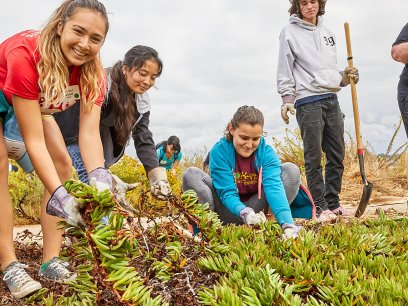
To track environmental changes, researchers require numerous observations, measurements, monitoring, and data sets to be collected. Engaging non-professional volunteers in scientific investigations allows researchers to collect such information on a larger scale. This approach to data collection, known as citizen science, has been useful in tracking trends associated with a changing climate such as earlier bloom times for plants in the spring, altered arrival times and locations of migratory birds, earlier and longer allergy seasons, and shifting habitats of frogs, pollinators, and other US wildlife.
Using citizen science to collect more information allows scientists to better understand what is needed to develop management plans on how to adapt to a changing climate. For example, managers at the Great Smoky Mountains National Park use citizen science data to monitor phenology at the park and track when frogs begin to call, wildflowers bloom, and songbirds return in the spring. This data has been used to understand the effects of climate change on parks.
Get Involved:
Participate in the citizen science projects below to take part in tracking a changing climate and contributing to conservation.
- Nature's Notebook aims to record 2 million citizen science records this year to track key seasonal changes in plants and animals.
- Project Budburst engages citizens in tracking the timing of leafing, flowering, and fruiting phases of plants throughout the year for native species.
- NestWatch is a nationwide bird monitoring program that tracks reproductive related data such as when nesting occurs, number of eggs laid, how many eggs hatch, and how many hatchlings survive.
- The Monarch Larva Monitoring Project uses citizen science data to conserve monarch butterflies and advance knowledge on butterfly ecology.
- FrogWatch USA encourages participants to examine frog distribution, timing of calls, and other data.
- Mountain Watch in the Appalachian Mountains encourages hikers to monitor air quality and report the timing of blooms for trees and flowers.
- YardMap asks individuals to draw maps of their backyards, parks, farms, favorite birding locations, schools, and gardens to gain a better understanding of US bird habitat.
Learn More:
- Explore the Surrounded by Science infographic to learn how citizen science can be used in places as close as your front door to the solar system.
- Learn more about how the scientific community benefits from citizen science in the Citizen Science is Blooming infographic.
Sources:
- Hurlbert, A., Liang, Z. 2012. “Spatiotemporal Variation in Avian Migration Phenology: Citizen Science Reveals Effects of Climate Change.” PLoS ONE 7(2): e31662. http://journals.plos.org/plosone/article?id=10.1371/journal.pone.0031662
- National Park Service. 2018. “Climate Change: Citizen Science.” Accessed July 3. https://www.nps.gov/subjects/climatechange/citizenscience.htm
- National Park Service. 2016. “Using Citizen Scientists to Document Life Cycle Change.” Accessed July 3, 2018. https://www.nps.gov/articles/greatsmokiesphenology.htm
- Tulloch, A., Possingham, H., Joseph, L., et al. 2013. “Realising the Full Potential of Citizen Science Monitoring Programs.” Biological Conservation. Volume 165. Pg 128-138. http://www.sciencedirect.com/science/article/pii/S0006320713001754


